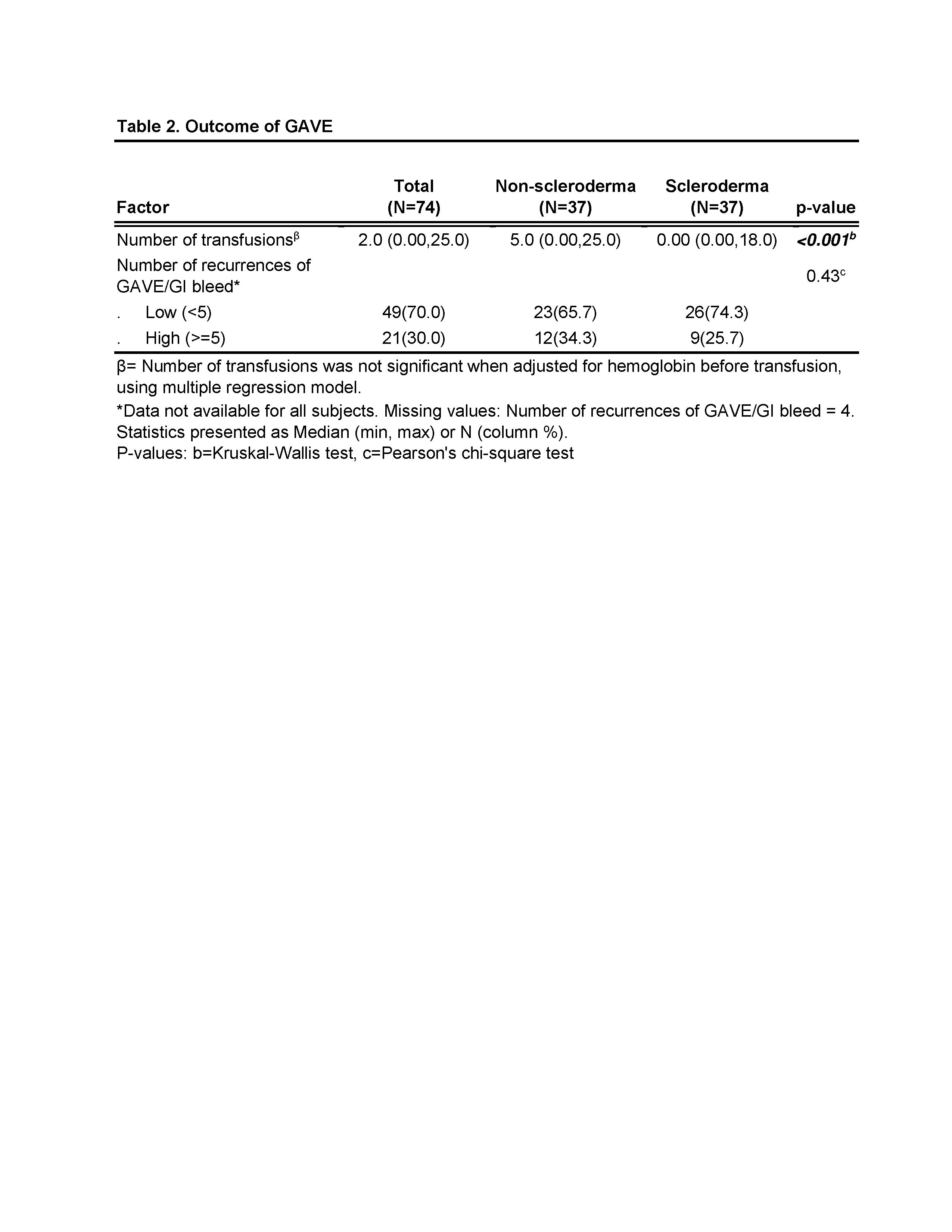Session Information
Date: Tuesday, October 23, 2018
Title: Systemic Sclerosis and Related Disorders – Clinical Poster III
Session Type: ACR Poster Session C
Session Time: 9:00AM-11:00AM
Background/Purpose: Gastric antral vascular ectasia (GAVE) is a pathologic angioectasia with a characteristic endoscopic appearance. Rugal folds with dilated blood vessels radiate from the antrum and converge at the pylorus resembling watermelon stripes, supporting the name watermelon stomach. It can cause anemia and significant morbidity, hence needs surveillance. GAVE has been associated with cirrhosis of liver, autoimmune diseases (e.g. systemic sclerosis (SSc), rheumatoid arthritis, primary biliary cholangitis), ESRD, hypertension, heart failure, hypothyroidism, chronic pulmonary disease and hematopoietic stem cell transplantation. Prevalence of SSc associated GAVE is highly variable ranging from 1% to 76%. Prevalence of GAVE in other associated diseases and its long term outcomes are still unknown. We aimed to compare the differences in GAVE in SSc with that in other diseases.
Methods: We conducted a retrospective chart review of patients with GAVE at a single referral center. We evaluated patients diagnosed with GAVE between 2012 – 2017; 145 GAVE patients were initially identified. We selected 37 consecutive SSc and 37 consecutive non SSc patients from the GAVE database. Outcomes were defined by number of transfusions, number of recurrences of GAVE bleeding diagnosed endoscopically (low <5 or high ≥ 5), and death. Groups were compared using ANOVA and Kruskal Wallis tests for continuous variables and Pearson’s chi square tests or Fisher’s exact tests for categorical variables. Also, comparisons were made using linear regression to adjust for covariates.
Results:
Clinical manifestations associated with GAVE in SSc and non-SSc groups respectively, were telangiectasias (29.7% vs 0%), melena (37.8% vs 86.5%), hematemesis (5.4% vs 8.1%), fatigue (86.5% vs 81.1%), dyspnea (19.4% vs 24.3%) and lightheadedness (2.8% vs 8.1%).
Patients were followed for a median of 5 years. When adjusted for pre-transfusion hemoglobin, difference in transfusion requirements was not statistically significant between the two groups. There was no difference in use of NSAIDs and anticoagulants between the two groups. There was also no difference in number of recurrences of GAVE. Two patients with cirrhosis of liver died.
Conclusion: Our study demonstrates that SSc patients with GAVE were significantly younger than those with non-SSc GAVE, and were mostly females. There was little difference in the presentation, severity and outcome of GAVE between the two groups. In future, further studies with larger cohorts of GAVE patients may be helpful in understanding its natural history and outcomes in specific diseases with which it is associated.
To cite this abstract in AMA style:
Mirza R, Jin Y, Kirby DF, Chatterjee S. Comparison of Gastric Antral Vascular Ectasia Associated with Systemic Sclerosis with That Associated with Other Diseases: Are There Differences? [abstract]. Arthritis Rheumatol. 2018; 70 (suppl 9). https://acrabstracts.org/abstract/comparison-of-gastric-antral-vascular-ectasia-associated-with-systemic-sclerosis-with-that-associated-with-other-diseases-are-there-differences/. Accessed .« Back to 2018 ACR/ARHP Annual Meeting
ACR Meeting Abstracts - https://acrabstracts.org/abstract/comparison-of-gastric-antral-vascular-ectasia-associated-with-systemic-sclerosis-with-that-associated-with-other-diseases-are-there-differences/


